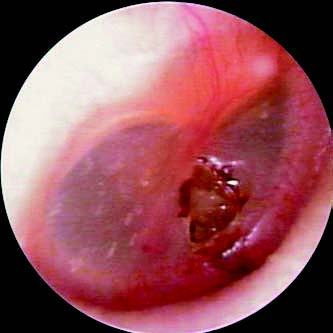The tympanic membrane, located deep within the external auditory canal, plays an important role in sound transmission. Tympanic membrane trauma is typically caused by direct or indirect external forces.
Etiology
Main causes include:
- Instrumental injury, for example, puncturing the tympanic membrane while using objects such as matchsticks or toothpicks to clean the ear
- Iatrogenic injury, such as damage caused during procedures to remove cerumen or foreign bodies from the external auditory canal
- Barotrauma, caused by events such as slapping the ear, explosions, blasts, high diving, and diving
- Other causes, including direct injuries such as longitudinal fractures of the temporal bone
Clinical Manifestations
After tympanic membrane rupture, there is a sudden onset of ear pain, immediate hearing loss accompanied by tinnitus, a small amount of hemorrhage in the external auditory canal, and ear fullness. Simple tympanic membrane ruptures result in mild hearing loss. Barotrauma, in addition to causing tympanic membrane rupture, may also lead to inner ear damage due to violent movement of the stapes, resulting in vertigo, nausea, and mixed hearing loss.
Examination
The tympanic membrane often shows irregular or slit-like perforations. The external auditory canal may contain bloodstains or blood crusts, and the edges of the perforation may exhibit mild hemorrhage. Hearing tests may reveal conductive or mixed hearing loss.

Figure 1 Traumatic tympanic membrane perforation
Treatment
Any residual foreign bodies, blood clots, or pus should be removed from the external auditory canal.
Colds and violent nasal discharge should be avoided to prevent infections from the nasopharynx. If there are no signs of infection, antibiotics are not necessary.
If there is no secondary infection, irrigating the external auditory canal or applying ear drops should be avoided. Until the perforation heals, swimming or allowing any liquid into the ear is strictly prohibited. Most traumatic perforations heal spontaneously within 3 - 4 weeks. For larger perforations, under sterile conditions and with the aid of a microscope, the edges of the tympanic membrane that have turned inward into the tympanic cavity can be repositioned, and sterile paper can be applied to promote healing. For perforations that do not heal, tympanic membrane repair surgery may be performed electively.
Prevention
Public health education should be enhanced to discourage the use of sharp objects for ear cleaning. Caution and care should be exercised when removing foreign bodies or cerumen from the external auditory canal to avoid damaging the tympanic membrane. In situations involving explosions, such as blasting, firing cannons, or setting off firecrackers, cotton or fingers should be used to plug the ears. Wearing protective earplugs provides even better protection.